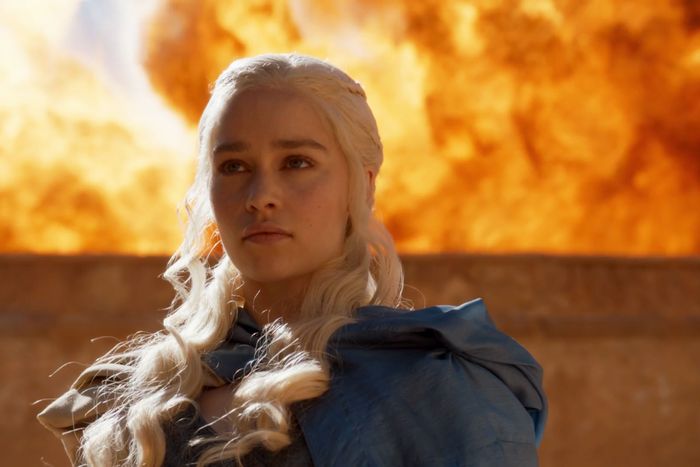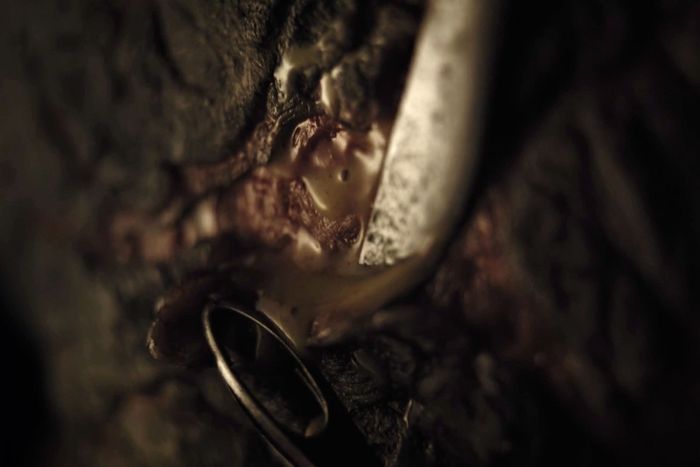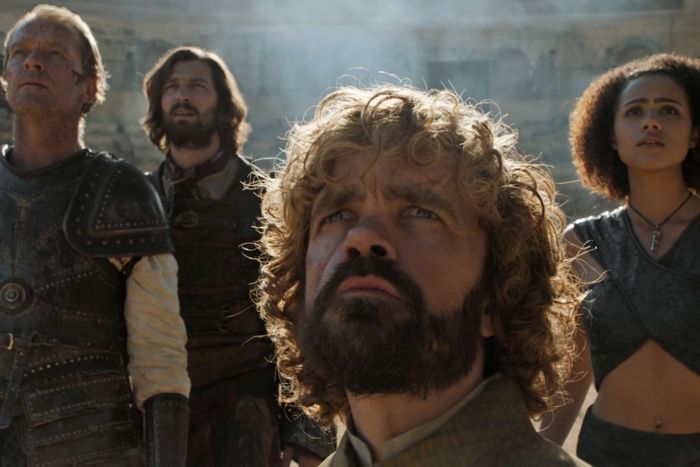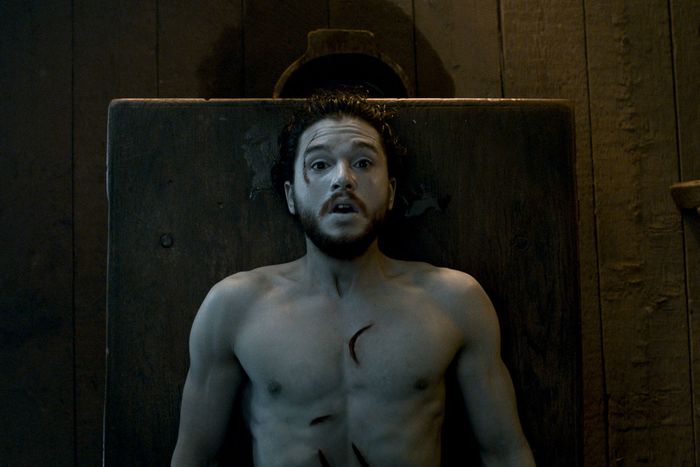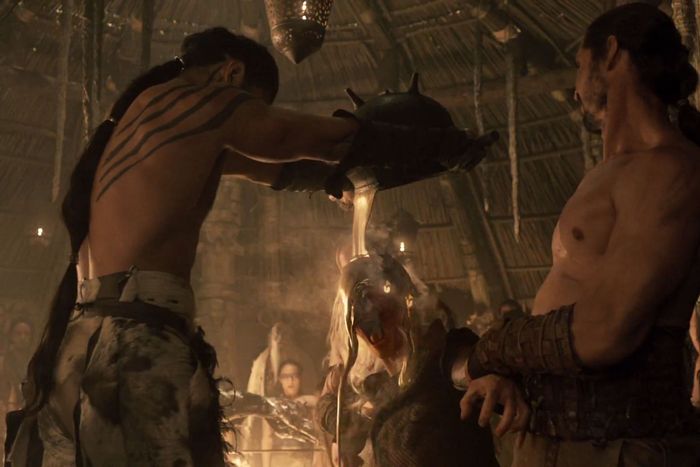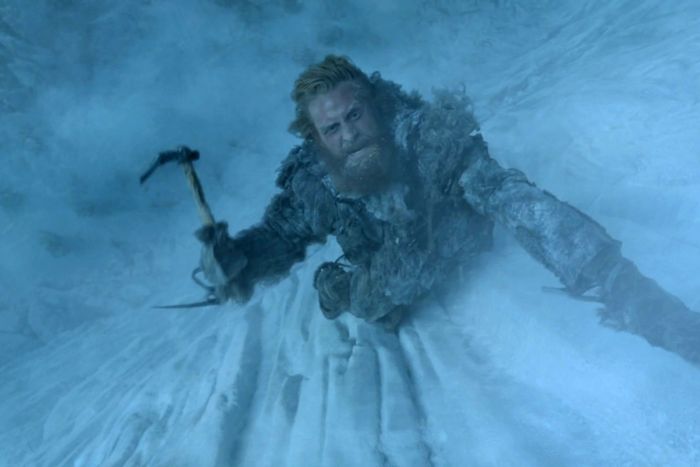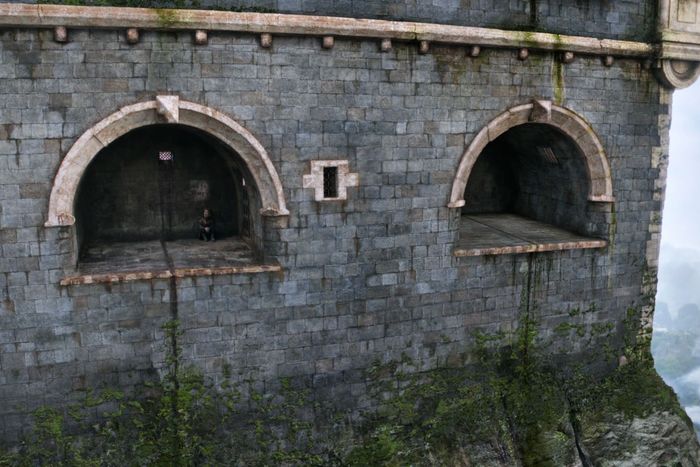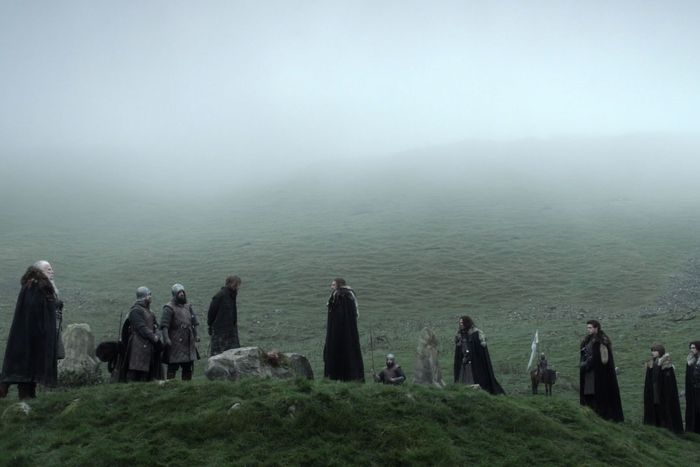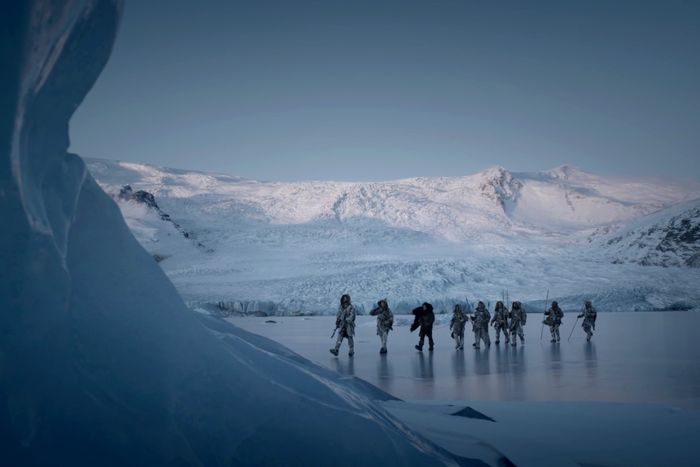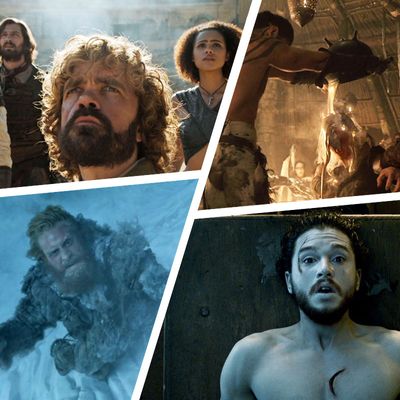
The army of directors behind Game of Thrones each faced a behemoth task: How do you make every episode as ambitious and visually rich as a big studio movie? It takes a rare set of skills to helm production for a show with such a massive following, so it’s perhaps no surprise that Thrones has relied on directors whose credits span a generation of TV hits, such as Breaking Bad, Westworld, Lost, Sex and the City, The X-Files, The West Wing, The Sopranos, Mad Men, True Blood, The Newsroom, Grey’s Anatomy, Black Mirror, and The Wire. With the eighth and final season mere days away, we asked 11 of the show’s most prolific directors to choose their favorite shots from the episodes they filmed. Mark Mylod reminisced over pus and pies, while Daniel Minahan revealed the moment that made Jason Momoa’s hands shake. Read on for all the stories behind these all-time Thrones shots.
Michelle MacLaren: “The Bear and the Maiden Fair” (Season 3, Episode 7)
“I spent a huge amount of time crafting this scene ahead of filming, working closely with the bear wrangler and the storyboard artist, drawing every shot in advance in great detail. We shot three-quarters of the scene in Northern Ireland and then reconstructed part of the set in a Los Angeles parking lot where we shot the bear portion. We needed to make sure that the actors always knew where the bear was going to be for eye line and that what we were asking of the bear was realistic. There are green screen and split-screen shots in this sequence, but there was no CGI bear. This is 100 percent bear, and when the bear hits Brienne, that is a real hit. One of the bear trainers, Smitty, happened to be tall and lean and although he had long hair and a beard, he was willing to shave the beard, wear a wig, and put on a pink dress doubling for Brienne. A truly amazing GOT experience.”
Alex Graves: “And Now His Watch Is Ended” (Season 3, Episode 4)
“For all the battles and weddings that I filmed, this single close-up depicted one of the largest shifts in the overall GOT story. Daenerys was taking the Plaza of Pride and winning her Unsullied Army by using the awesome force of her dragons for the first time. There wasn’t a lot of money left for too many VFX, so I came up with what the crew called the Apocalypse Now shot … a slow push on Emilia standing by, expressionless, as four sets of real high explosives were let loose behind her, depicting her dragon’s awesome destructive power. It was not easy to get high explosives into North Africa at the time, but we did, ultimately getting the shot in one take, primarily because Emilia’s performance was, as usual, perfect.”
Mark Mylod: “Stormborn” (Season 7, Episode 2)
“We cut from a scalpel, about to pierce poor Ser Jorah’s greyscale encrusted chest, to a spoon stabbing into a crusty pie, before delivering the slimy filling to a hungry mouth. It’s completely disgusting. Both sides of the cut are close-ups and miles from the epic sweeps that are synonymous with the show. And yet the amount of work that went into that tiny moment, from so many different departments working together to create the perfect gross moment, is extraordinary: Barry Gower and his incredible prosthetics team evolving the perfect color and viscosity for the pus and blood, the perfect ooze when the greyscale is pierced. Iain Glen heading into make up at 1:30 a.m. with not the slightest grumble. Our food technicians evolving the pie crust design to match the greyscale contours and shading, without poisoning the actor. Meeting after meeting over months for one fleeting moment. That’s why I love Game of Thrones.”
David Nutter: “The Dance of Dragons” (Season 5, Episode 9)
“My favorite individual image is in the immediate aftermath of that huge gladiatorial-style battle (in the Daznak’s Pit). This final shot is essentially a point of view, from the bowels of the pit, of Dany flying off dramatically into the sky on the back of her dragon. The camera then tracks slowly around to reveal that we’re seeing all this from the perspective of an utterly awestruck Tyrion. And then Jorah, Daario, and Missandei — all similarly stunned — step up to watch, too. But we end on Tyrion’s reaction, and the exquisite look on his face, and his ‘I have never seen a woman like that before’ moment.”
Jeremy Podeswa: “Home” (Season 6, Episode 2)
“For sheer cultural impact, I would choose this shot depicting the resurrection of Jon Snow in season six (hello, it was even parodied on SNL!). The murder of Jon Snow at the end of the previous season was the definition of a cliffhanger. And the viewers’ reaction to it all over the world was, I think, without precedent. I have never been asked so many times (begged even) to reveal a spoiler concerning anything I have ever worked on.
The creators of the show very cleverly waited until the second episode of the season to bring Jon Snow back, adding to the tension and uncertainty connected to his fate. My challenge as a director was to keep the suspense going, and to not tip the hand until the very last moment. I knew that the audience had been waiting a long time for this question to be resolved and the anticipation was at peak level. The moment had to come as a surprise. The lead-up to the shot — Melisandre’s detailed ceremony to bring Jon Snow back to life (and her perceived failure) — sets the stage for this moment: Jon’s rebirth, shot simply and graphically in a formal composition that deliberately invokes Christian iconography, with Jon Snow as a Christlike figure, his head “crowned” by a bowl that suggests a halo.
In discussing the actual moment of resurrection with Kit Harington, we felt the strongest physical manifestation of the moment would be one that invoked a literal re-birthing, like a newborn violently bursting into the world seizing its first gasp of breath, or someone who has been held underwater now rising to the surface and taking a first powerful intake of air. Kit played it beautifully. The moment is powerful and thrilling and, if fan reaction videos are any indication, entirely satisfying. Genuine screams of shock and delight? What more could a director want? Mission accomplished!”
Daniel Minahan: “A Golden Crown” (Season 1, Episode 6)
“The shot of Drogo pouring molten gold over Viserys’s head is most memorable, not because of a virtuosic camera move, but because of performance and the difficulty level was set at about 11, and we had to get it in one take. There were weeks of preparation for the gag. Finding a viscous material that could be colored gold and that we could pour like molten metal. Building a wig for Viserys laced with air tubes to produce bubbles and steam when the viscous gold paint hit his head. A molded gold skullcap that would be switched as if the gold had cooled into a golden helmet.
There were discussions, fittings, and rehearsals with Harry Lloyd to discern just how he would react to scalding hot liquid poured on Viserys’s head. How he would fall, wired to a rig of air tubes. How Jason Momoa would lift the cauldron and pour the melted metal out onto Harry’s head. Seemingly small details, but everything needed to go like clockwork. Removing the paint, changing, cleaning and re-wigging the actors would be impossible.
So on the day, we rehearsed the stunt for the crew, and our director of photography Matt Jensen carefully placed three cameras trained on Jason, Harry, and one on the side. The special effects team prepped the molten gold and smoking, bubbling wig on Harry. Jason rehearsed the pouring move in pantomime, then with an empty caldron. Harry rehearsed his fall. Then, finally, we crossed our fingers and set out to do it. Jason came to me and showed me his trembling hands. He is unflappable, but this had him rattled.
Action: Jason lifted the smoking cauldron, approached Harry who was screaming for his life, and then Jason stopped and called cut. Something was wrong, didn’t feel right — his grip, his approach, something. He’s pretty shook up and makes apologetic eyes to me across the set. We reset to go again.
Action: Jason lifts the cauldron, crossed to Harry — who I’m worried is squirming too much trying to get away and might be a moving target — but then, at the perfect moment, Jason lifts the cauldron over his head and pours a perfect stream of golden goo down onto Harry’s snow-white hair that smokes and bubbles and seems to burst into flames (which we would add in later in VFX). Harry dropped to the ground and Jason laughed a hearty belly laugh. The gag worked. The crew cheered and Jason (maybe) took a victory lap. Harry got golden goop in his eyes and the hair and makeup team swarmed around him. We all huddled around the playback monitor to watch it back. All three cameras got beautiful shots and we all sighed a huge sigh of relief.”
Alik Sakharov: “The Climb” (Season 3, Episode 6)
“Of all the beautifully and aesthetically composed shots I had framed on GOT, it is actually a very simple image that I hold in high regard. Not much explanation is needed — the picture itself tells the whole story.”
Brian Kirk: “The Wolf and the Lion” (Season 1, Episode 5)
“This crane shot started within a tiny set, erected on a spindly scaffold tower in the parking lot of the Titanic Studios. At the highest point of the crane arm, the set was dwarfed within the frame by the view northeast out of Belfast toward the Titanic Dock and the George Best Airport. It was a chaotic vista, soon to be replaced by the stunning visual effects artistry of BlueBolt. However, when I look at the shot now, I still see the collision of worlds it represented to me at the time and that still makes me smile.
I grew up 40 miles west of Belfast in the town of Armagh at a time when there was little or no film industry in Northern Ireland. The peace process unlocked the door to change that, but GOT kicked it wide open. I remember standing in the parking lot that day thinking, This is huge and against all odds it is happening here. Fantasy is real.”
Tim Van Patten: “Winter Is Coming” (Season 1, Episode 1)
“The wide shot showing the deserter being marched to his execution is one that has stayed with me over the years. I wanted to establish a visual language that would speak to the tribal power structure of this strange world we are inhabiting. This is the first 12 minutes of the series, we’re watching these characters and we’re trying to figure out: What is this place? What are the rules here? Why must our hero take on this duty? You can see Ned is standing alone with the condemned man, isolated from his children and guardsmen. The act of this execution is Ned’s burden and he must do it alone.
Suddenly, we understand this world and these characters a little better — and we want to know more. Luckily the weather was on our side that day, so it made sense to shoot this big, haunting wide shot that would help convey the tension that is broiling inside Ned, moments before he takes this man’s life.”
Neil Marshall: “The Watchers on the Wall” (Season 4, Episode 9)
“It’s easy to talk about my favorite shot from Game of Thrones, because it’s probably my favorite shot of anything I’ve done. The 360-degree crane shot in ‘Watchers on the Wall’ evolved from that wonderful organic process that filmmaking can often be. There was nothing in the script about it. If anything, it acted as a transition between two existing scenes. Instead of ‘cut to’ or ‘dissolve to,’ it might have read ‘swing the camera around the entire battle to,’ but it didn’t.
The seeds were sown the moment I walked into the Castle Black set. It’s set out like a regular fort, with a large flat area in the center surrounded by buildings and fortifications and parapets. On those buildings were several walkways, sets and galleries, and I immediately thought that the surrounding areas were by far the more interesting place to stage the action, rather than the flat ground in the center. Instead, I figured that flat ground was an ideal place to put a camera crane, and since the set was 360 degrees, it meant I could swing that camera in every direction.
So, if this represented the what and the how, then came the question of why? A cool shot is only really cool when it serves a purpose, and we didn’t have time for needless self-indulgence. So what was the motivation for such a shot? And more importantly, how could I sell the need for it to the producers and writers? The answer was geography. Understanding geography within an action sequence is integral for the audience to get fully involved. At this point in the story, there were several of the main characters involved in various pieces of action around the Castle. What my 360 crane shot would do was link all of them together at the same time in one sweeping move, that passed from character to character, showing exactly where they were and how they related to each at that point in the fight.
The main thing the stunt team had to watch out for was the crane itself, which at full extension, swinging around in a fast circle, could have taken one of their heads clean off!
On the night in question, we’d scheduled this shot as first up. We rehearsed the moves for an hour or so, then nailed the shot in seven takes. It was one of those perfect moments when every department came together, their imaginations fired up by trying something new and a little daring. There was a real buzz on set that night, and a genuine sense of satisfaction among the cast and crew that we pulled it off so spectacularly. It achieved everything I hoped it would creatively, and practically we pulled it off in record time without any mishaps. That’s when you smile to yourself and say, I love this job.”
Alan Taylor: “The Prince of Winterfell” (Season 2, Episode 8)
“GOT is a show that allows you to reach for epic, dynamic visuals. But when asked to pick a favorite shot, my mind goes to something very simple — a transition shot. Jon Snow has been captured north of the wall. We see him being lead by his captors, to join up with a band of wildlings. The shot is brief, but it means a lot to me.
We had been scheduled to shoot the scene on the shore of a small lake in Iceland. When we arrived, the lake had frozen over. We walked out to scout the new terrain — a mixed crew, Icelandic, English, and American. When we were about a hundred feet out, the ice flexed and made a sound like distant thunder. Most of us darted back to the shore, but the Icelanders kept walking, and so I realized it was safe. Instead of shooting by the lake that day, we shot ON it, in amongst the mini icebergs.
Nature can often create problems when shooting on location. This was one of those wonderful occasions when it improved on our plans.”


